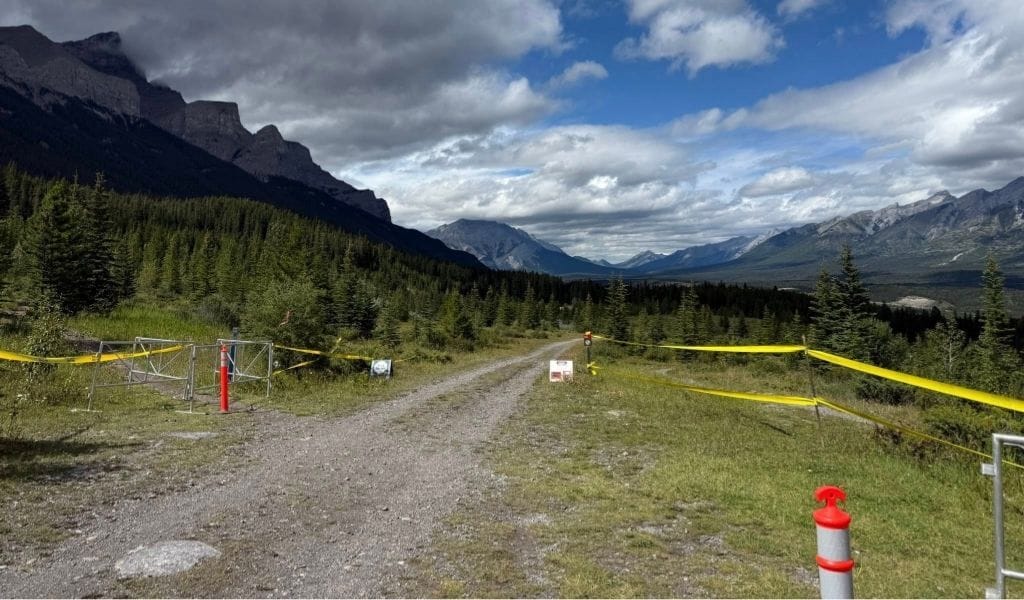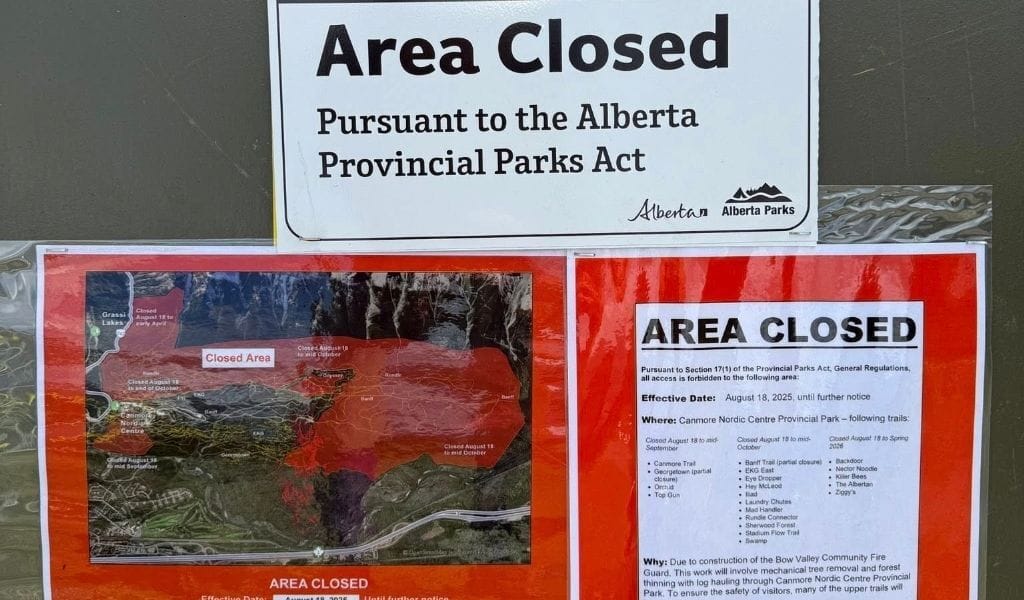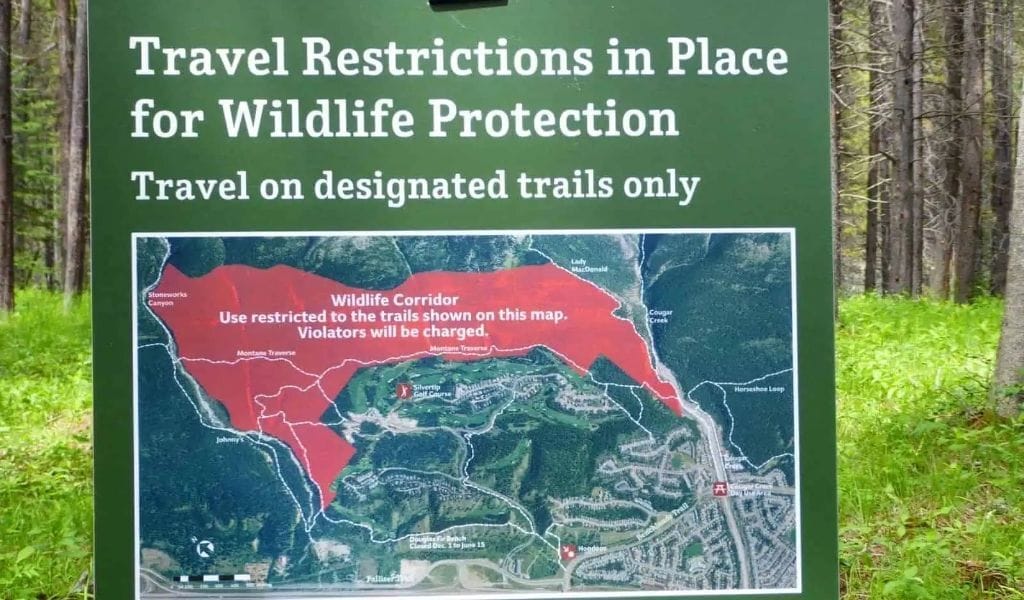- Bow Valley Insider
- Posts
- A New Study Says “Guilt” Might Be Canmore’s Secret to Protecting Wildlife
A New Study Says “Guilt” Might Be Canmore’s Secret to Protecting Wildlife
Research shows conscience plays a bigger role than community pressure in keeping wildlife safe.

CANMORE, Alberta, The next time someone turns around on a trail because they spot a bear, it might not be because of the warning sign at the trailhead. It might just be guilt.
A new University of Alberta study looking at trail behaviour in the Canmore area says the single strongest factor that predicts whether people will follow wildlife-related rules, like backing off when they see a bear or staying out of wildlife corridors, is their own internal sense of obligation. Not their friend group. Not social pressure. Not polite trailhead messaging. Their own personal norms.
“Personal norms were statistically significant across all models,” the authors wrote, calling them “the only variable significantly associated with both wildlife- and trail-specific pro-environmental behaviours.”
Put more simply, people who feel personally responsible for not stressing out bears, wolves, and cougars are the same people who are most likely to act responsibly around them.
The finding matters here because the Bow Valley is now managing a tight, high-conflict space: more people, more dogs, more bikes, more trail networks, and the same narrow movement corridors used by large carnivores. Town officials and land managers have been trying for years to get people to “coexist” with wildlife while still accessing recreation. That coexistence is not abstract. In practical terms it usually means “do not push wildlife out of the last pieces of usable habitat” and “don’t train bears to think your campsite is a buffet and force a bear to be destroyed.”
This new work suggests the standard approach, more signage saying please stay on trail and more messaging about what good visitors do, may not be the lever everyone thought it was.
What the researchers did

The study, led by Michelle N. Murphy with co-author Elizabeth A. Halpenny, surveyed people using popular trailheads around Canmore between June 2 and August 1, 2023. Researchers intercepted hikers, bikers, and dog walkers at seven access points and also posted QR codes at trailheads, community hubs, and local hotels. They collected 601 usable surveys.
Participants were asked how often they actually do specific things managers care about, using a 1-to-7 scale where 1 meant “never” and 7 meant “every time.” Those behaviours included:
staying on authorized trails
avoiding closed areas and wildlife corridors
turning around and going back to the trailhead if they encounter a “wary species” such as bears, wolves, or cougars
encouraging other trail users to also turn around
skipping trails with active wildlife warnings
reducing recreation in certain places or at certain times so predators can use those areas with less human pressure
People generally said they follow trail rules at high rates. On average, respondents scored 6.7 out of 7 for “avoid areas where recreational activities are prohibited” and 6.58 out of 7 for “stick to the trail designated for your activity.”
Wildlife-related decisions scored a bit lower and were more variable. The average agreement with “turn around after spotting a bear, wolf, or cougar” was 5.65 out of 7, and “limit recreation use in designated wildlife corridors” was 5.39 out of 7.
After collecting behaviour responses, the team tested three psychological drivers:
Personal norms. “I feel obligated to minimize my negative impact on the environment,” “I would feel guilty if I stressed wildlife,” and “I feel a personal obligation to follow trail closures.”
Social norms. “Other people on the trail think I should follow closures,” and “People who are important to me think I should reduce my impact on wildlife.”
Place attachment. In plain language, emotional connection to the Canmore trail network. Statements like “I am very attached to the trails around Canmore” and “I feel happiest when I visit these trails.”
The researchers then looked at whether those mental frames actually predicted behaviour on the ground.
What they found

Only one factor consistently mattered: personal norms.
“Personal norms emerged as the only significant cognitive predictor,” the study says. They were “strongly and positively associated” with wildlife-related behaviours in particular, such as turning back when you see a cougar, or staying out of a corridor at dusk so an animal can move through.
Social norms, the sense that “other people expect this of me,” were not significant once personal norms were accounted for.
That result ran against what some park staff expected. Managers interviewed by the researchers before the survey “speculated strong community support for both trails and local wildlife,” which is another way of saying they believed social pressure in Canmore is already intense. But when the models were actually run, “social norms became insignificant.”
The message is uncomfortable if you are in charge of communications. A sign that says “Most visitors stay on trail” might not move behaviour in the way it is supposed to. A campaign that leans on “your friends expect you to leash your dog” may sound good but can fail in practice once someone is actually several kilometres up a drainage and the dog is off lead chasing a scent line.
In contrast, messages that activate conscience, such as “I would feel guilty if I stressed a cougar out of critical habitat,” or “I feel personally responsible for not walking into a closed wildlife corridor,” are the ones most closely tied to what people actually do.
The authors argue this is where Bow Valley agencies should lean in. They write that “messaging that fosters a sense of personal responsibility… could enhance pro-environmental behaviour on trails.” They also point to ambassador-style outreach, a human at the trailhead who can have a conversation, as one of the most promising tools in other jurisdictions, because it can make that sense of responsibility feel immediate and specific instead of generic.
It is not “locals good, tourists bad”
One of the most politically loaded questions in the Bow Valley is: who is the problem, locals or visitors.
On that front, the study cuts against an easy narrative.
Researchers assumed residents of Canmore and Exshaw, people who live here and talk about wildlife coexistence on Facebook every day, would report stronger pro-environmental behaviour than visitors. They tested that directly by splitting the sample using postal codes and running separate comparisons.
That hypothesis did not hold.
“There were no significant differences” in either wildlife-related or trail-related behaviour between locals and non-locals, the study reports. Local respondents and visiting respondents scored nearly the same on things like staying on designated trails and avoiding closed areas.
In other words, people flying in for a mountain weekend were just as likely to say they turn around when they see a bear as people who have lived here 20 years.
The researchers note that in other tourism-heavy places, it is actually common to see tourists report higher “green” behaviour than residents. Visitors can arrive in “treat this place like a sanctuary” mode, while locals slowly normalize conflict, for example “that elk always beds down behind Safeway, do not worry about it.” The Canmore result, no real difference, might mean two things. Either visitors here are not careless, or locals are not as consistently exemplary as they think. The authors say they did not separate first-time visitors from repeat visitors, which could hide important differences like “Banff regular versus first-timer from Toronto.”
Who is most likely to actually do the careful thing

The models did find two demographic patterns around wildlife behaviour.
Respondents who were older and respondents who identified as women were more likely to report doing the careful thing for wildlife: backing off, avoiding active wildlife warnings, limiting use in corridors, and similar actions. Younger respondents, and men, were less likely to report doing those things every time.
That is not unique to Canmore. Previous research has found women are often more likely to report pro-environmental behaviours across a range of contexts. The study notes that evidence on age is more mixed in the literature, and can depend on activity type and setting.
It is worth slowing down on what those “wildlife behaviours” actually are, because they are not soft asks. They are things many trail users actively resist in public debate:
“Turn around, returning to the trail head after spotting a wary species (bears, wolves, cougars, etc.) on trail.”
“Encourage other visitors to turn around.”
“Reduce recreational activities at certain times to avoid scaring away or stressing wary species (bears, wolves, cougars, etc.).”
“Limit recreational use in areas designated as wildlife corridors.”
Those are not “pack out your orange peel” behaviours. Those are “you do not get to ride here at dusk because this is for the wolf pack” behaviours. In a valley that argues about seasonal closures every single spring, that is politically significant.
Place attachment did not protect wildlife
One of the surprises in the data is what did not matter: place attachment.
People in the survey generally scored high on emotional connection to the local trail network. Many agreed with statements like “I am very attached to the trails around Canmore” and “I feel strong, positive feelings for the trails around Canmore.”
But that emotional bond did not predict whether they actually behaved in ways that reduce stress on predators or respect closures.
That is a big deal for messaging because so much Bow Valley outreach leans on love-of-place. The logic has always been: if we remind people how special this valley is, they will act accordingly. This study suggests that loving the valley and acting in a way that protects it are not automatically the same thing.
The authors suggest one possible reason. “Canmore Trails Area” may just be too broad to trigger protective behaviour. People often bond with specific places like “my morning loop,” “that drainage where I ski with my dog,” and “the Highline climb I have ridden for 15 years.” The study says attachment at that micro-scale might drive behaviour more than general “I love Canmore” identity.
In other words, a blanket “Protect Canmore’s Trails” campaign might not work as well as “Protect Cougar Creek at dusk. You know this drainage. You run here. This is where the cats move.”
Why this matters now
For years, Canmore, Banff, and the province have said in public documents that the Bow Valley is under pressure: too many people on too many trails pushing into the last usable habitat for apex predators and pushing conflict to the edge. A 2018 multi-agency report called for reducing human activity in wildlife corridors, creating predictable use, and closing or seasonally restricting some access so that wildlife can move without constant human encounters.
Those recommendations are always controversial. Every time a closure goes up, social media fills with versions of the same argument: “Why are you shutting this down. I live here. I care. I know what I am doing.”
This new research does two things to that argument.
First, it undercuts the idea that locals are automatically better behaved than visitors. The data did not find that.
Second, it makes the case for targeting conscience, not status. If guilt, obligation, and “I am personally responsible for not pushing a bear out of its feeding area right now” are what move behaviour, then land managers have a clearer path.
The paper even sketches out what that could look like on the ground: trailhead signage and in-person “ambassadors” that speak directly to the hiker or rider in front of them, in plain language, about a single concrete behaviour at a single place and time.
Not “be a responsible trail user.”
Instead: “It is 7 p.m. and bears are feeding here. Turning around now protects them. Most of us are heading back out. You will feel better about your impact if you do the same.”
The authors argue these kinds of messages do not just tell people what the rule is. They tell people why they, personally, will feel bad if they break it. And according to the data, that feeling is the thing that predicts what happens next on the trail.
You can read the full study, “The psychological drivers of pro-environmental behaviors on recreational trails in Canmore, Alberta,” published in the Journal of Outdoor Recreation and Tourism, at ScienceDirect.
Reply